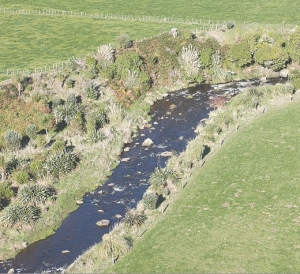Farming depends on good quality water for stock and, generally speaking, better water quality means healthier animals and higher productivity. But intensive farming, forestry, roading and horticulture can cause soil erosion, and build-ups of contaminants such as bacteria and chemicals washed into watercourses by heavy rain.
So managing the margins of waterways – the so-called riparian zones – helps protect water quality on farmers’ own properties and those of their downstream colleagues.
On the water quality front, a well-managed riparian margin – which animals are kept away from – will filter out sediments and nutrients from farm run-off. These contaminants can include soil, dung and urine, phosphates and nitrates from fertilisers, and agricultural chemicals. Besides helping boost animal health, cleaner water means drainage pipes are less likely to block.
Stream bank erosion is another way sediments and nutrients get into waterways. Assets such as land and buildings can also be threatened by erosion. Shrubs and trees with extensive fibrous root systems, and which tolerate moist soil conditions and frequent silt deposition, are ideal for preventing stream bank erosion. Tree roots also protect the streambed, limiting the scouring effect of running water.
Good riparian vegetation can be effective in reducing the impact of flooding as it helps regulate water getting into waterways.
Shade from riparian vegetation can help prevent algal blooms and provides cover for aquatic life such as spawning fish. Trees also help stimulate aquatic life and provide a habitat for birds.
Enhancing the environment of waterways adds to the attractiveness of the local environment and its recreational values for locals and tourists.
Financial benefits for farms include shelter and shade boosting animal health and production.
Also, improved milk grades are documented where dairy sheds no longer draw water from contaminated streams. On sheep and beef properties, stock are generally in better health and have faster weight gain when water sources are no longer contaminated.
Riparian management, including the associated fencing of waterways, helps with stock movement and reduces stock losses.
It’s important to get the right riparian management regime for individual farms to ensure the benefits are maximised.
• Bala Tikkisetty is a sustainable agriculture coordinator at Waikato Regional Council.
Tel. 0800 800 401
This email address is being protected from spambots. You need JavaScript enabled to view it.
















